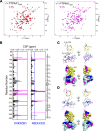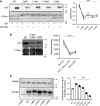Oxidative stress promotes fibrosis in systemic sclerosis through stabilization of a kinase-phosphatase complex
- PMID: 35451370
- PMCID: PMC9089796
- DOI: 10.1172/jci.insight.155761
Oxidative stress promotes fibrosis in systemic sclerosis through stabilization of a kinase-phosphatase complex
Abstract
Systemic sclerosis (SSc) is a fibrotic autoimmune disease characterized by pathogenic activation of fibroblasts enhanced by local oxidative stress. The tyrosine phosphatase PTP4A1 was identified as a critical promoter of TGF-β signaling in SSc. Oxidative stress is known to functionally inactivate tyrosine phosphatases. Here, we assessed whether oxidation of PTP4A1 modulates its profibrotic action and found that PTP4A1 forms a complex with the kinase SRC in scleroderma fibroblasts, but surprisingly, oxidative stress enhanced rather than reduced PTP4A1's association with SRC and its profibrotic action. Through structural assessment of the oxo-PTP4A1-SRC complex, we unraveled an unexpected mechanism whereby oxidation of a tyrosine phosphatase promotes its function through modification of its protein complex. Considering the importance of oxidative stress in the pathogenesis of SSc and fibrosis, our findings suggest routes for leveraging PTP4A1 oxidation as a potential strategy for developing antifibrotic agents.
Keywords: Autoimmune diseases; Fibrosis; Inflammation; Rheumatology.
Figures








References
Publication types
MeSH terms
Substances
Grants and funding
LinkOut - more resources
Full Text Sources
Medical
Miscellaneous

